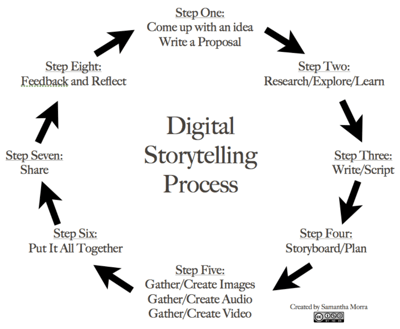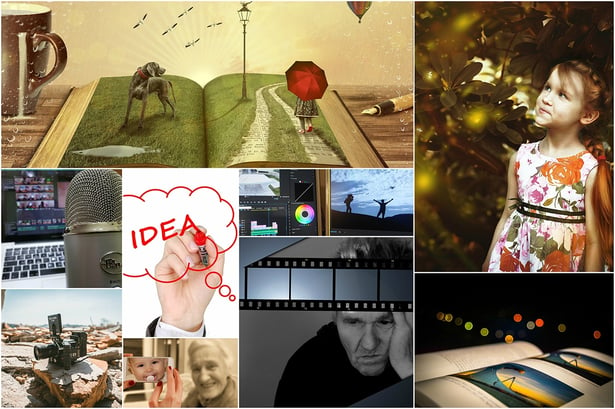“Great stories happen to those who can tell them.” - Ira Glass
“What I want to do is share with the audience the process of discovery…” - Ken Burns
“The technology keeps moving forward, which makes it easier for the artists to tell their stories and paint the pictures they want.” - George Lucas
Why Digital Storytelling?
Over the past decade, a wide range of technology resources have entered the classroom, providing teachers and students new ways of sharing knowledge and ideas. Storytelling traditionally has been the under the domain of English/Language Arts (ELA), so early adopters of digital storytelling have been ELA teachers who have experimented with this concept and worked hard to pave the way for others. More teachers have taken notice, and today, digital storytelling strategies have been adopted by teachers across many other disciplines.
A review of the literature regarding the research and practice of digital storytelling tells us that there are many reasons for educators to use digital storytelling with their students, in and out of the classroom:
- Develop a deeper sense of self
- Develop imagination and creativity
- Develop a deeper sense of sequence and cause and effect
- Develop a sense of story
- Develop a sense of inter-relationships, how things connect, compare, and contrast
- Develop deeper observational skills, on many levels
- Develop planning skills
- Develop writing skills
- Develop technology skills using various tools and apps
- Develop skills in the arts
- Develop technology-integrated communication skills, across all subjects
If your goal this school year is to ramp up your students’ digital storytelling skills, the first step is to ramp up your own skills by integrating digital storytelling strategies into your day-to-day teaching. One good resource for adults—and older students, is the StoryCenter, previously known as the Center for Digital Storytelling. There you can find a wide range of examples of digital storytelling and links.
The core principles of the StoryCenter are as follows:
- Everyone has many stories to tell.
- People need to be heard.
- Listening is hard.
- People see, hear, and perceive the world in different ways.
- Creative activity is human activity.
- Technology is a powerful instrument of creativity.
- Sharing stories can lead to positive change.
If you are interested in learning more about digital storytelling, take the time to review the resources below.
Alternatively, if you'd like to learn more from Lynn Marentette, you can get in contact by clicking the following button:
Resources
Getting started with Digital Storytelling in the Classroom
This guide is free and can be obtained through the Tech4Learning website. It provides teachers with resources about digital storytelling and how it can be used across the curriculum. There are several engaging lesson plans that can be modified for a range of age levels.
Video: 7 Elements of Digital Storytelling in 4 minutes
This video provides an overview of the seven elements of digital storytelling that were developed by the Center for Digital Storytelling: 1. Point of View; 2. Dramatic Question; 3. Emotional Content; 4. Gift of Your Voice; 5. Power of the Soundtrack; 6. Economy; 7. Pacing
8 Steps Great Digital Storytelling, Samantha Morra, EdTech Teacher
In this post, Samantha Morra outlines an eight-step process for digital storytelling. She provides linked resources for each step outlined in the chart below:

The StoryCenter provides digital storytelling online and in-person workshops. Digital stories on a variety of topics are in the “Stories” section of the website and are suitable for students in high school as well as adults. The StoryCenter’s Core Principles of Digital Storytelling can be downloaded here.
21st Century Storykeepers Resources Wiki
This wiki provides information, tutorials, and resources related to media-making and digital storytelling, including storyboarding templates.
Digital Storytelling for Social Impact, Jay Geneske, Rockefeller Foundation, 5/6/14
This post provides an overview of how digital storytelling can inspire action and positive change in our world. The researchers at the Rockefeller Foundation conducted interviews and held round-table sessions with people from different fields. The outcome of the report, found at the end of the post, provides good information for teachers of high-school students who are interested in learning more about digital storytelling and the role of digital media in present-day life.
Student Interactive Story Map, ReadWriteThink
The Interactive Story Map is an online tool provided by ReadWriteThink, a provider of free materials for use in reading and language arts instruction. Although the Interactive Story Map was designed to support writing skills, the graphic organizers are ideal for planning digital stories. There are lessons suitable for grades K-12.
“The Story Map interactive includes a set of graphic organizers designed to assist teachers and students in prewriting and postreading activities. The organizers are intended to focus on the key elements of character, setting, conflict, and resolution development. Students can develop multiple characters, for example, in preparation for writing their own fiction, or they may reflect on and further develop characters from stories they have read. After completing individual sections or the entire organizer, students have the ability to print out their final versions for feedback and assessment. The versatility of this tool allows it to be used in multiple contexts.”
Further reading
Javorsky, K., & Trainin, G. (2014). Teaching young readers to navigate a digital story when rules keep changing. The Reading Teacher, 67(8), 606-618.
Smeda, N., Dakich, E., & Sharda, N. (2014). The effectiveness of digital storytelling in the classrooms: a comprehensive study. Smart Learning Environments, 1(1), 6.
Nowell, S. D. (2014). Using disruptive technologies to make digital connections: stories of media use and digital literacy in secondary classrooms. Educational Media International, 51(2), 109-123.
Brenner, K. (2014). Digital Stories: A 21st-Century Communication Tool for the English Language Classroom. In English Teaching Forum (Vol. 52, No. 1, pp. 22-29). US Department of State. Bureau of Educational and Cultural Affairs, Office of English Language Programs, SA-5, 2200 C Street NW 4th Floor, Washington, DC 20037. Chicago

 3-in-1 Mic
3-in-1 Mic




